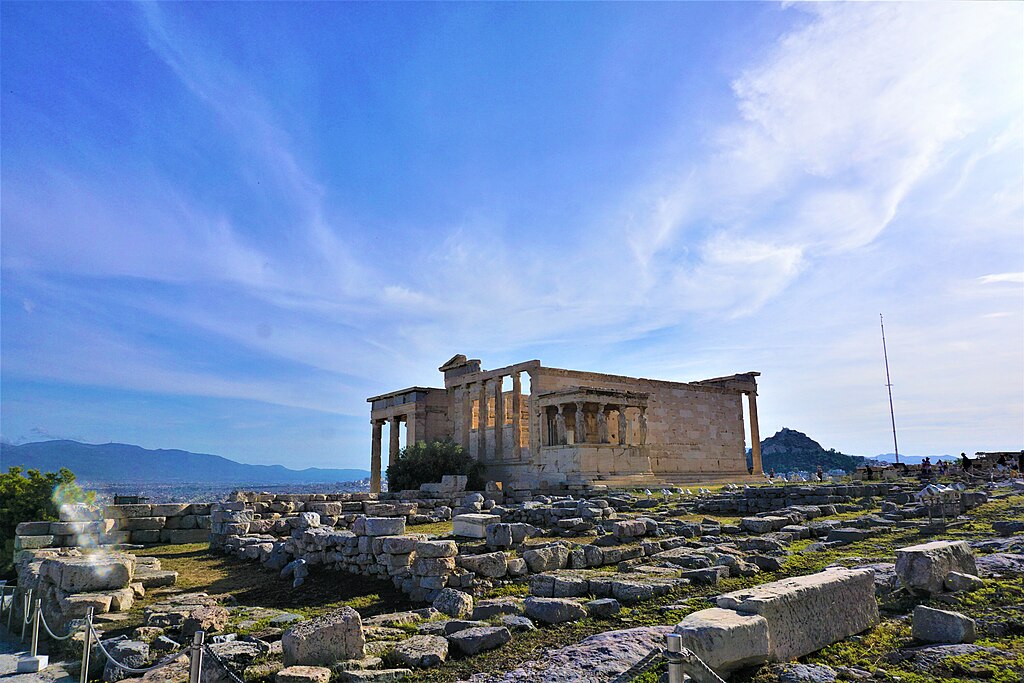
This 5,000-year-old “Egyptian Stela Fragment” is a Stele that depicts a seated couple, sculpted in sunken relief. It shows a wife and husband with the small figure of a servant holding a jar and offering a drink of beer to the man with Hieroglyphic text above the figures.
The Hieroglyphic inscription above the seated figures does not preserve the name of the male, but it records his title as:
“Royal Chamberlain of the Great House.”
The name and title of the wife are “Redu-ihu.
Sunk or sunken relief, as opposed to low relief, is a sculpture style mainly seen in the art of Ancient Egypt where it is common. The image is made by cutting the relief sculpture itself into a flat surface.

A complete example of sunk-relief. The background has not been removed, merely that near the sculpted form. Strong shadows are needed to define the image.
The figure itself is in low relief but set within a sunken area shaped round the image so that the relief never rises beyond the original flat surface. This method minimizes the work removing the background while allowing standard relief modeling.
Beer in Ancient Egypt
As almost any cereal containing certain sugars can undergo spontaneous fermentation due to wild yeasts in the air, beer-like drinks were developed soon after the Egyptians had domesticated cereal.
Beer became a vital part of the daily diet of Egyptian pharaohs over 5,000 years ago. Then, it was made from baked barley bread and was also used in religious practices.
During the building of the Great Pyramids in Giza, Egypt, each worker got a daily ration of four to five liters of beer, which served as both nutrition and refreshment that was crucial to the hard work of pyramid construction.
Funerary models of a bakery and brewery, from the Eleventh dynasty of Egypt, circa 2009–1998 BC have been found showing the workers making beer.
In Egyptian mythology, the immense blood-lust of the fierce lioness goddess Sekhmet was only sated after she was tricked into consuming red-colored beer, believing it to be blood. She became so drunk that she gave up slaughter and became docile.
Egyptian Stela Fragment
- Title: Egyptian Stela Fragment
- Culture: Egyptian – Old Kingdom
- Provenience: Egypt, Dendereh, Cemetery
- Period: Old Kingdom, Sixth Dynasty – Seventh Dynasty
- Date Made: 2350 – 2130 BC
- Find date: 1898
- Materials: Limestone
- Dimensions: H: 30.5; W: 28.5; D: 10.5
- Museum: Penn Museum
Reading the Stela
Explore the Pennsylvania Museum of Archaeology and Anthropology
- Marble Portrait of Agrippina the Elder
- Herm of Herakles and Hermes
- Marble head of Emperor Caracalla
- Cult Statue Head of Diana
- Wine Transport Amphoras
- Greenstone Mask
- Egyptian Stela Fragment
- Sumerian Cone or Clay Nail
- Clovis Weapons & Tools
- Mayan Altar
- Shawabti of King Senkamanisken
- Coptic Pendant Crosses
- Jar Handles with Judean “Royal Stamp”
- Historical Objects of the Penn Museum
Secrets of the Egyptian Hieroglyphics
Decoding Egyptian hieroglyphs
~~~
“The only wealth which you will keep forever is the wealth you have given away.”
– Marcus Aurelius
~~~
Photo Credit: GM 2) By Unknownmyself (Gerbil from de.wikipedia) (Own work) [Public domain, GFDL (.gnu.org/copyleft/fdl.html) or CC-BY-SA-3.0 (creativecommons.org/licenses/by-sa/3.0/)], via Wikimedia Commons
Popular this Week








 Sponsor your Favorite Page
Sponsor your Favorite Page SEARCH Search for: Search Follow UsJoin – The JOM Membership Program
Sponsor a Masterpiece with YOUR NAME CHOICE for $5
Share this:
- Tweet
